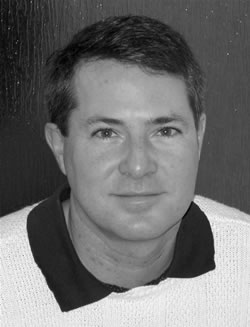 “I started diving in submersibles when I was eight, began piloting ROVs at the age of eleven, designed my first ROV at fifteen, and started working in the oil fields offshore at twenty-one,” says Jim McFarlane. “I’ve worked in oil/gas services, military mine countermeasures, search and recovery, and survey and oceanographic research.” He also spent fifteen years at the Monterey Bay Aquarium Research Institute before starting his own company, McFarlane Marine Services.
“I started diving in submersibles when I was eight, began piloting ROVs at the age of eleven, designed my first ROV at fifteen, and started working in the oil fields offshore at twenty-one,” says Jim McFarlane. “I’ve worked in oil/gas services, military mine countermeasures, search and recovery, and survey and oceanographic research.” He also spent fifteen years at the Monterey Bay Aquarium Research Institute before starting his own company, McFarlane Marine Services.
So he’s well suited to serve as chair of the MATE Center’s National Visiting Committee (NVC), or advisory board. “Our role is to listen to the Center staff about where their programs are going and what their concerns are, and then provide recommendations and guidance,” he explains. “As the chair, I record the minutes of the annual NVC meeting, direct the conversations among the participants, and then prepare the annual report that helps the staff move forward.”
"I’ve worked in oil/gas services, military mine countermeasures, search and recovery, and survey and oceanographic research"
A Changed Landscape
The field of marine technology has changed for the better since the MATE Center’s inception, according to McFarlane. “There’s a huge repository of centralized information and many new partnerships between industry and the educational community that didn’t exist previously,” he explains. “There was a hole in the education system, and MATE has done a great job of partnering with industry to address its training needs.”
McFarlane highlights the Center’s affiliation with the Marine Technology Society (MTS) as an example of its strong relationship with industry. MTS has co-sponsored and helped to support both regional and national student ROV design competitions each year, and from this year on the current MTS president will serve on the NVC.
The Center has had many successes in its six-year history, but McFarlane points to three, in particular, that stand out in his mind:
- Winning approval of its Marine Science and Technology program by the California State Chancellor’s office
- Its extensive database of colleges and industry contacts
- The annual student ROV design competition
Looking to the Future
What about the next few years? “Certainly becoming more self-sustaining is the Center’s big goal,” he says. “They’re making great strides in that direction already.”
He also lists further program development (more accredited A.S. degrees in technology) and additional diversity (regarding both gender and race as well as technology disciplines). “Consider ROVs and hydrographic surveying, for example,” he says. “There are many similar skills sets, such as for mechanical, electronics, and software technicians. But there are also specific areas in each discipline that need focus, such as side scan or multi-beam sonar operations in the survey world. Programs that have the ability to focus on some of these different areas will be a big plus. This in turn will provide better qualified technicians to industry and science.”
As the Center moves forward, the NVC will be right there to assist it. “The NVC continues to be the greatest supporter of the MATE Center and its staff,” says McFarlane. “We believe in it and believe its continued success is imperative to the technologists of the future.”
<< Back to Profiles Start Page
|
|
